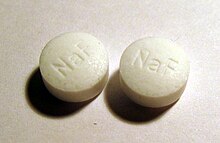User:Mr. Ibrahem/Fluoride therapy
 Fluoride is sold in tablets for cavity prevention. | |
| Clinical data | |
|---|---|
| Trade names | OrthoWash, PerioMed, others |
| AHFS/Drugs.com | Monograph |
| License data | |
| Routes of administration | by mouth |
| Legal status | |
| Legal status | |
Fluoride therapy is the use of fluoride for medical purposes.[3] Fluoride supplements are recommended to prevent tooth decay in children older than six months in areas where the drinking water is low in fluoride.[4] It is typically used as a liquid, pill, or paste by mouth.[5] Where public water supplies are fluoridated further fluoride by mouth is typically not needed.[5] Fluoride has also been used to treat a number of bone diseases.[6]
Normal doses may occasionally result in white marks on the teeth.[5] Excessive doses can result in brown or yellow coloring of the teeth.[5] Fluoride therapy typically uses the sodium fluoride form, though stannous fluoride may also be used.[5][6] Fluoride appears to decrease breakdown by acids, increase remineralisation, and decrease the activity of bacteria.[6] It is believed to work mostly through direct contact with the teeth after they have emerged.[4][6]
Fluoride came into use to prevent tooth decay in the 1940s.[7] Fluoride, as sodium fluoride, is on the World Health Organization's List of Essential Medicines.[8] In the United Kingdom a typical month supply costs the NHS about £0.36.[5] It is also not very expensive in the United States.[9] In 2016, sodium fluoride was the 215th most prescribed medication in the United States, with more than two million prescriptions.[10]
References[edit]
- ^ Mosby's Review Questions for the National Board Dental Hygiene Examination. Elsevier Health Sciences. 2013. p. 231. ISBN 9780323226318. Archived from the original on 18 September 2017.
- ^ "WHOCC - ATC/DDD Index". www.whocc.no. Archived from the original on 28 March 2019. Retrieved 12 September 2020.
- ^ Weiner, Eugene R. (2008). Applications of Environmental Aquatic Chemistry: A Practical Guide, Second Edition (2nd ed.). CRC Press. p. 389. ISBN 9781420008371. Archived from the original on 18 September 2017.
- ^ a b World Health Organization (2009). Stuart MC, Kouimtzi M, Hill SR (eds.). WHO Model Formulary 2008. World Health Organization. pp. 501–2. hdl:10665/44053. ISBN 9789241547659.
- ^ a b c d e f British national formulary : BNF 69 (69th ed.). British Medical Association. 2015. pp. 699–700. ISBN 9780857111562.
- ^ a b c d "Fluorides". The American Society of Health-System Pharmacists. Archived from the original on 3 June 2016. Retrieved 8 January 2017.
- ^ Murray, John J.; Nunn, June H.; Steele, James G (2003). The Prevention of Oral Disease. OUP Oxford. p. 53. ISBN 9780192632791. Archived from the original on 18 September 2017.
- ^ World Health Organization (2019). World Health Organization model list of essential medicines: 21st list 2019. Geneva: World Health Organization. hdl:10665/325771. WHO/MVP/EMP/IAU/2019.06. License: CC BY-NC-SA 3.0 IGO.
- ^ Hamilton, Richart (2015). Tarascon Pocket Pharmacopoeia 2015 Deluxe Lab-Coat Edition. Jones & Bartlett Learning. p. 217. ISBN 9781284057560.
- ^ "The Top 300 of 2019". clincalc.com. Archived from the original on 12 February 2021. Retrieved 22 December 2018.
